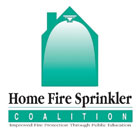
I used to believe that fire sprinklers belong in green buildings for one reason: To protect the environmentally conscious occupants and the eco-friendly structure itself. Sprinklers, in other words, would serve pretty much the same necessary function that they do in any occupied building.
PM Engineer Editorial Director Julius Ballanco linked fire sprinklers and green construction in a recent column in PM magazine. I learned more about the connection when I visited the Home Fire Sprinkler Coalition (HFSC) booth at the American Fire Sprinkler Association convention in September in Phoenix.
I have advocated both fire sprinklers and green buildings for a long time, as I mentioned in this space a couple months ago, but never in the same breath or magazine column. While other products and systems certainly can use the marketing boost that the green movement provides, fire sprinklers stand on their own merits of saving lives and protecting property.
The safety factor would trump the environmental benefits in any discussion of fire sprinklers, and I told Peg Paul of the HFSC that in Phoenix. She explained to me why sprinkler advocates are broadening their view to include green construction, and I have to admit that the connection makes sense.
When a building burns, all that rubble is dumped into a landfill. But it doesn’t stop there. Even when a fire is contained, smoke can damage mattresses, couches and other furniture that may look perfectly fine but smell terrible. Those furnishings wind up in landfills as well.
Besides saving landfill space, sprinklers conserve water. I wasn’t aware that a typical firefighting hose uses 250 gallons per minute. Sprinklers use a fraction of that amount.

Smoke coming from a fire pollutes the air, the level of toxicity depending on the building’s contents. Years ago, as a newspaper reporter, I covered a fire in an unsprinklered building that housed a landscaping business. I recall not wanting to be anywhere near the place if the barrels of weed killer and insecticides started to explode.
After the smoke clears and it’s time to rebuild, trees are cut down for the wood needed to construct and furnish the new building. Metals, fuels and other materials are consumed unnecessarily if the original building could have been saved with fire sprinklers.
When we think about green buildings, we tend to focus on the structures themselves as well as the products and systems that save energy, conserve water and improve air quality. Bringing fire sprinklers into the green building discussion drives home the point that we should be looking at the broader implications of the green movement. These are the environmental resources that are used up in getting rid of old building debris and constructing new buildings.
Fire sprinklers remain a safety-first product to me. Sprinklers as part of the green building movement, nevertheless, make a compelling argument as well.
